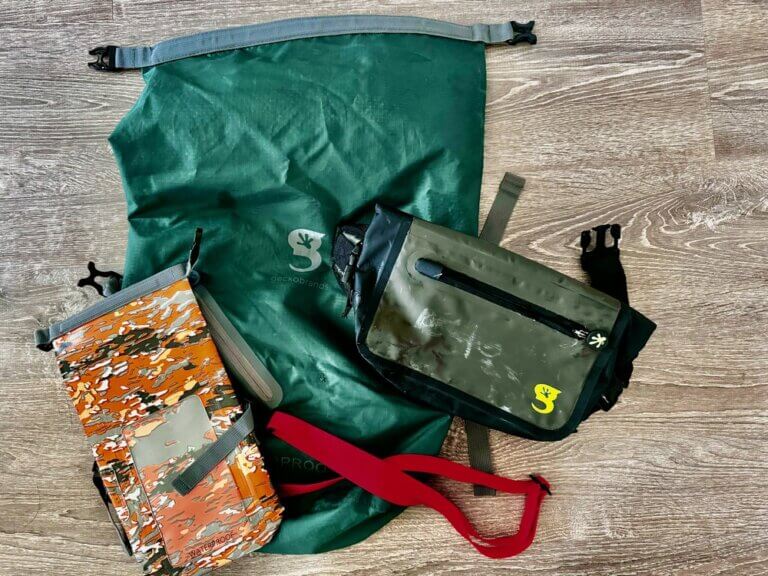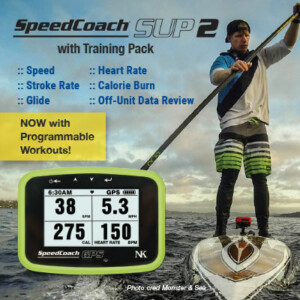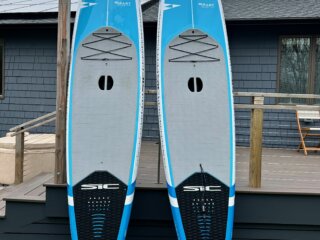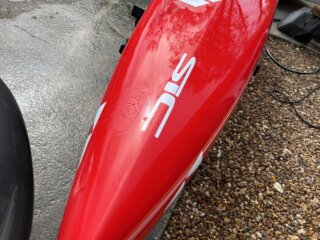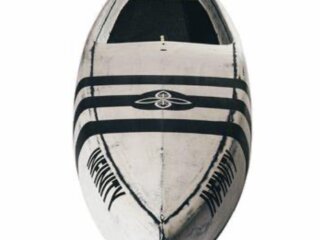
Why and How Cold Weather Doesn’t Have to Keep You off the Water
If you live in some place that’s warm year-round and have never had to contemplate paddling in freezing, icy, conditions you don’t need to read any further. On the other hand, if you have some morbid curiosity about what it’s like for those in northern climates who want to paddle throughout the year, by all means read on.
Before I start, let me state unequivocally that I hate being cold. Despite being Canadian, I’ve never been a big winter person and would rather hibernate than enjoy the great outdoors for most of December, January and February. I’m a summer guy, and I do summer sports. Maybe it’s because I grew up in southern Ontario, where ski runs are short and lift lines are long that I don’t have much time for skiing or snowboarding. To do either, I have to drive at least a couple of hours, stand in lines all day, and freeze in biting cold and wind, just to enjoy a few good runs. It all seems so pointless and a bit of a waste of time. Were there mountains in my backyard I’m sure I’d feel differently. Cross-country skiing is a more appealing option in my part of the world and I do it a few times a year but, where I live, it still involves a lot of driving. As such, I’ve never really gotten into it in the way I have paddling. For my entire career as a sprint canoe paddler, once frozen off the water I pretty much confined myself to strength work and a ton of running and swimming as my aerobic training activities.
However, once I started stand up paddling and then retired from teaching, I discovered that there’s no reason to stop paddling just because the river is frozen and the temperature is below freezing. I discovered that SUP lends itself to paddling on big open water like Lake Ontario through an entire winter in a way sprint canoe doesn’t. I discovered that it’s actually possible, with the right gear and some common sense, to paddle safely all winter and ENJOY IT. So, let’s take a look at winter paddling and, if you’ve never done it before, how to get started. I’ll share a few ideas that can help you extend your paddling season safely, productively and enjoyably and make the winter seem to pass by a little more quickly.

It’s only as cold as you think it is
The most important thing to understand about winter paddling is that, if geared up properly, it’s only as cold as you think it is.
Before I realized what is actually possible, I wouldn’t have dreamt of doing anything on the water when the air temperature drops below freezing and the water temperature hovers around it. These conditions seem nasty for walking the dog, let alone paddling. Throw a wind chill on top of that, where the “feels like” temperature is well below freezing, and it seems like an insane idea to go out and do anything on the water. Yet ask yourself, would you go for a run, downhill ski, or cross-country ski in those conditions? Of course you would.
How is going for a SUP paddle on flat water any different than going for a run? If you’re confident that you’ll stay dry and are geared up properly in case you don’t, it’s basically the same thing. Even if you’re paddling in rough water it’s not really any different, provided you respect the conditions and make sure your threshold for safe conditions is a little more conservative than it is in the summer.
You’ll find that with the right gear you barely notice the water temperature when you fall in and that not only is it quite safe to paddle in freezing temperatures (assuming you’re taking the necessary safety precautions), you can actually be toasty warm while doing it. Get the idea that it’s insane to paddle in the winter out of your head. It can be warm and comfortable and, because you’re wearing the proper gear, it might actually be safer than the paddling you normally do in the spring and fall when you aren’t geared up to the same degree.
Gearing up
You’re going to have to spend a little longer getting ready to paddle in the winter than you do in the summer. It’s no longer just a case of putting on some board shorts and some sunscreen and getting out there. Let’s look at all the gear you’ll need, from head to toe. I want to stress that I’m not doing product reviews. While we’ll do some product reviews in future issues, here we’re just looking at the type of gear you need to enjoy your paddling safely and productively.
Boots
These are essential whether you’re paddling in the flats or on rough water and you’ll wear them more throughout the year than any other piece of cold weather gear, starting somewhere in October and stretching right through the winter until mid-May. Basically, you’ll wear them almost every day you paddle when the air and water temperatures drop below 10 C (50 F).
If your feet have ever gotten really cold while paddling you’ll understand just how miserable it can be and how cold feet can totally mess up your balance and your ability to paddle properly. Icy cold feet lose all their feeling and proprioception. It becomes hard to just walk properly on land with cold feet, let alone move around on your board and feel it underneath you. And since your feet are going to get wet, even in flat water, they’re going to get cold way faster than if you were just walking around on shore in bare feet or sandals. You definitely want to protect them, and what you’re going to need to do that are some good quality neoprene boots.
I prefer to use 7mm or 8mm neoprene boots that are not split toe. Thinner boots will work for temperatures above freezing, but if you’re going to paddle in colder conditions they won’t keep you warm enough, and split toed boots separate your big toe from the other four, which means they can’t keep each other company and keep each other warm. It also means you can’t wear socks underneath your boots, and that is something that is essential once the temperatures fall below freezing. I make sure my boots are big enough to allow me to put a pair of merino wool socks on underneath when needed. Again, that’s not possible in split toed boots.
Gloves
You’re likely to wear gloves more than any other piece of cold weather paddling clothing except for your boots. Once the wind chill drops to close to freezing you’ll definitely be happier with gloves on your hands. Paddling with cold hands is almost as bad as paddling with freezing cold feet. They will limit your ability to hold on to your paddle properly, risking it slipping in your hands (which can lead to you swimming) and cold fingers take a long time to warm up afterward. I’ve had trouble changing after paddling and tying my board on the car afterward with cold hands. You’ll find yourself sitting in the car with the heater cranked trying to warm up your hands so you can button up your pants and tie your board down if you’re not careful.
I use 3mm neoprene gloves all winter. Admittedly, these aren’t very thick and shouldn’t be warm enough in deep freeze conditions, but I find thicker gloves really limit my ability to properly feel the paddle and can really make my forearms tighten up as a result. This can have a big negative impact on your paddling and should be avoided. I’ve also tried neoprene mitts, which should be warmer than gloves, but I find that they also affect my ability to properly feel the paddle shaft in my hands and are really awkward when doing side changes.
So, how do you keep your hands warm in only 3mm gloves in a real deep freeze? I’ll share an awesome tip for doing this in the next section.
Something to cover your head
You lose a tremendous amount of heat through your head in cold temperatures if you aren’t wearing a hat, so some type of head covering in essential for winter paddling. I have two options that I use.
For days where I know I am not likely to fall in, I use a wool toque (Canadian for beanie) that comes down far enough over my ears to cover most of them when pulled down snug. This keeps my head and ears toasty warm. Unfortunately, if it gets wet it doesn’t do much to keep me warm and, in fact, is going to make my head freeze as it will be wet. I’ve been told that wool can keep you warm even when it’s wet, but I don’t think that applies to your head if it is sopping wet in deep freeze conditions. If you put a soaking wet wool cap on your head in subfreezing temperatures, I guarantee your head is going to freeze like an ice cube. So, when conditions get a little rougher in the winter and I think there is a chance that I am going to fall in, I wear a 1mm neoprene toque.
I’ve fallen in many times in winter wearing a 1mm neoprene toque and it still keeps my head warm. In fact, it’s pretty tight and tends to keep my head dry as well. I’ve SUP surfed many times in the winter with this toque on and been in the water a lot, totally submerged, and it still does the job. For most paddlers this should be very adequate winter head wear.
For those that are surfing or SUP surfing and are going to be in the water a lot, with their head often under the surface, a neoprene hood is probably a better choice. These are basically hood like hats that cover your entire head except for your face and extend down your neck far enough to fit under your wet suit. I find them a little confining and so rarely use one, choosing the neoprene toque instead, but if I were going to be in the water a lot in really cold conditions the hood would be my choice.
Dry suit or wet suit?
If you’re going to winter paddle safely, you need to be prepared to fall in and be able to get back on your board and paddle home without getting hypothermia. Something beyond the cool weather clothing you wear for paddling in the late spring or early fall is essential. You’ll need either a good wet suit or a dry suit and since they’re quite different, each with their pros and cons, let’s take a look at both.
Wet suit
A good dry-lock wet suit will keep you warm in just about any water if it’s thick enough. The upside of that is that it gives you a huge sense of confidence when you’re paddling in big, cold, water. You can paddle completely relaxed and uninhibited and totally go for it, whether you’re downwinding or SUP surfing. The downside is that, unless you’re in the water a lot, you’re likely going to overheat. Once that’s happened you’ll find it really difficult just to paddle easily, let alone work hard.
I use a 4/3 Excel dry-lock wetsuit when I’m on Lake Ontario in rough water, with air temperatures anywhere between -10 C (14 F) and 5 C (40 F) and water temperatures between 0 C (32 F) and 5 C (40 F). I don’t think you want to go with a suit that is any thinner than 4/3 in deep winter conditions. These days, since I own a few dry suits, I only use the wetsuit when it’s really rough, choppy, water or there’s big wind waves and swell. Basically, if I think there’s a good chance that I’m going to be going in, I’ll wear the wetsuit. Ironically, most days I wear it I actually don’t fall in, but it is still worth wearing in those conditions. First of all, I have such an elevated level of confidence wearing this suit that I end up paddling more relaxed and push my limits better than I otherwise would, and that’s when I’m most likely to improve. Secondly, when I do fall in, I’m really happy I’m wearing it. I barely feel the water and, because it’s a dry lock, there’s not even a hint of that uncomfortable trickle of cold water down my back. I certainly don’t experience that dangerous shock that takes your breath away and makes your muscles seize when you fall into icy water without any protection. In fact, I’ve jumped off my board before and swam like a seal through a densely packed cluster of ice chunks without even feeling them, which was pretty cool. In addition, these suits make you a little more buoyant so I feel extremely safe while wearing it.
If I am going to be in the water a lot, or for an extended period of time, I opt for a wet suit. Provided it’s thick enough, it is by far the safer option if you expect to be swimming a lot or in the water for a long time. Those are the pros, however there are cons.
Such a thick wetsuit is a little confining and restricts your movement a bit. You’ll definitely notice the difference between paddling in it versus paddling in a dry suit, which basically allows you to feel as unencumbered as you do while paddling in your board shorts. The bigger problem with a wet suit that is suitable for deep winter conditions is that, if you’re not falling in, you’ll usually be overheating after about 30 to 40 minutes, especially when the air temperature is a little on the warmer side. This is the big reason why I never paddle in a wet suit when a dry suit will safely do. Without a joke, I get so hot in these suits that I feel like I’m going to have a stroke. If I were a car I’d be on the side of the road with my hood propped up and steam billowing out. I frequently end up jumping off my board and sitting in the water with my arms draped over it, relaxing for as much as 10 minutes like that to try to cool off before getting back on and paddling again. While I’ve experienced some really pleasant Zen-like moments doing that, I’m inviting a 911 call from concerned people on shore who think I’m in trouble. That’s a hassle I don’t want and it’s not fair to either the person concerned enough to make the call or the first responder who answers it.
If you go the wet suit route and are planning on paddling everyday, you should really consider having two suits so that you can alternate them. Doing that means you’ll never have to crawl into a damp wet suit on a cold day, which isn’t much fun.
Paddling dry suit
The option I prefer for almost all of my winter paddling is a paddling dry suit. The idea with a dry suit is that you just put some running clothes underneath the suit and then go paddle. If the dry suit fits properly, you barely realize you have it on and you can essentially paddle as freely and unencumbered as you would in the summer. The under layer you wear provides the insulation and the outer layer of the suit keeps you dry when you fall in, allowing you to get back on your board and continue paddling. In theory, you stay completely dry inside a dry suit. In practice that rarely happens. I usually end up pretty soaked in sweat by the end of the paddle, but the great thing is that as cold as it is outside, it always feels like summer inside your suit if you’re working hard enough.
It’s important to recognize that a paddling dry suit should not be confused with a survival suit. These suits are just a light, thin layer of breathable waterproof fabric, which is part of what makes them so comfortable for paddling. However, they have no insulation value of their own. It’s the layers that you put on underneath them that keep you warm. Even if you’re layered up pretty well, if you end up in the water for any appreciable period of time, you’re going to get cold pretty quickly. You don’t want to make the mistake of thinking these suits give you a long survival time in cold water. If you think you might be in the water a lot, or for a prolonged period of time, choose a 4/3 wetsuit to paddle in. Not only will you have a much longer “safe in water” time but, if you’re repeatedly climbing back onto your board, you’re less likely to damage your wet suit than your dry suit, which is thin and rather delicate in comparison.
There are a number of different dry suit brands and not all are the same. Some are really thick and cumbersome and don’t breathe well at all. I had one of those once and it was miserable for paddling in. The zipper looked prehistoric and was stiff and really difficult to use while the latex neck gasket felt like it was going to strangle me. Moreover, it was poorly fitting and so contained too much air. When I ended up in the water, the air would be pushed by the water pressure to the top of the suit. This is fine if you go into the water feet first but inconvenient if you happen to go in face first. On more than one occasion I struggled to right myself after going in head first.
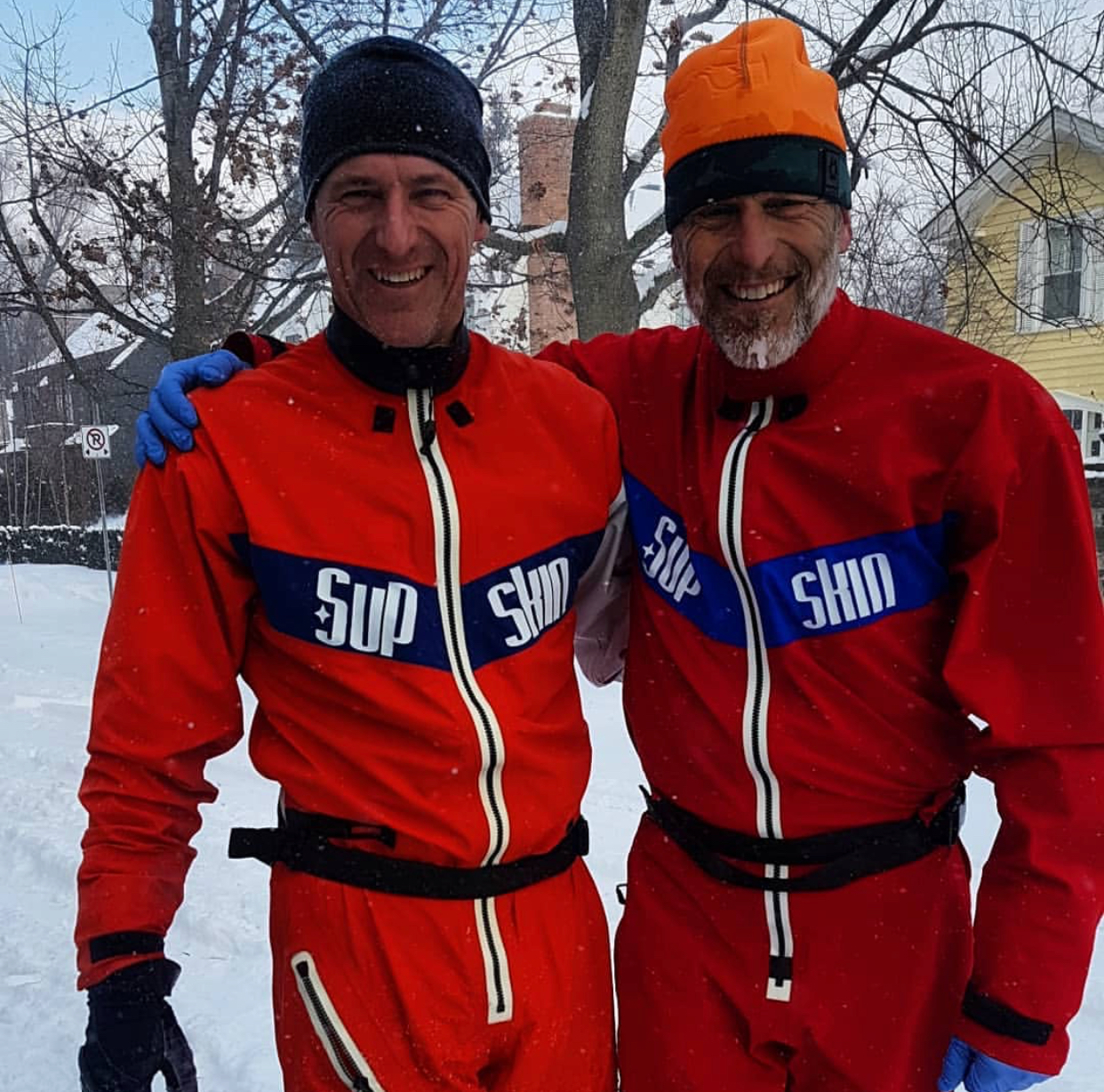
Although this isn’t a product review, you should be looking for a suit that is designed for SUP paddling. SUPskin (www.supskin.com ) really pioneered SUP specific dry suits and, in my opinion, still provide the best suits you can get, however there are other brands that market paddling suits as well like Level Six, Ocean Rodeo and Starboard, to name a few. If you’re looking for a paddling dry suit, shop around and ask questions of those who use them or sell them. Even if you don’t know anyone using one personally, any paddling group on social media will likely have members who use them who will be happy to answer questions or provide advice.
There are some features that you’ll want to consider when selecting your dry suit. First, you’ll want to decide whether you want a suit with “socks” integrated into it or no socks and ankle gaskets instead. The suits with integrated socks are essentially closed at the bottom of each leg with little foot-shaped socks built into the suit. You just put the suit on and then slip the suit socks into your boots and you’re ready to go.
As appealing and easy as a suit with the integrated socks sounds, after trying them I realized I prefer to use suits with ankle gaskets at the bottom of each leg. The legs on these suits look more like those on regular trousers and they have the same type of gaskets (but larger) at the ankles as they do at each wrist. This keeps water from running up your leg into the suit if you fall in. I prefer the suit with ankle gaskets because I can pull the gaskets over the tops of my boots and in doing so keep my feet totally dry while paddling. With the integrated socks and no gaskets, your boots can fill with water when you wade into the water to launch. Although your feet stay dry because of the socks, I find that if my boots are filled with cold water my feet get a little colder through the dry suit material. When you’re paddling in really cold conditions it’s nice to start off feeling as warm as possible, rather than freezing while you wait for your paddling effort to warm your feet up. Another con to the integrated socks is that they prevent you from wearing split-toe neoprene booties. Some paddlers prefer the split-toe style because they provide a better board feel and make thick neoprene booties feel less cumbersome.
Another feature that you’ll want to consider is what type of neck gasket the suit has, either neoprene or latex. Latex gaskets will be more watertight, but they fit a lot more snugly around your neck and I find them much less comfortable. Neoprene gaskets might allow a slight dribble to enter your suit if your head gets submersed, but they are very comfortable – not much different than wearing a comfortable turtle neck.
Lastly, you’ll want to consider the type of zipper – either diagonal across your chest or strait up your front from just below your waist to your neck. The straight zippered suits are easier to get in and out of and I find them to be slightly more comfortable, but really, once you’re paddling, there’s not a huge difference.
If you go the dry suit route, you’re going to have to also consider the clothes you wear underneath it. A variety of layering options from light running tights to thicker, fleece-lined tights and tops leave you prepared for pretty much anything. It will take you a while to figure out exactly what to wear under your suit in certain conditions and temperatures, and while you’re learning, you’ll likely have days where you’re cold and others where you overheat. But, once you’ve got it figured out you should be really comfortable almost every time you paddle regardless of the conditions.
The bottom line is, if you’re going to paddle safely and enjoyably deep into winter you’re going to need either a wet suit or dry suit. Even if you don’t end up falling in, safe paddling requires you to be prepared to and then be able to safely get back on your board and continue paddling without getting hypothermia. Just wearing cold weather running gear, for example, isn’t adequate.
Here’s a link to a video we posted a few years ago where I walk through gearing up for a paddle on a brisk, -17C (1 F) morning.
Safety
Clearly, being properly geared up is the first element in safe winter paddling. Failure to gear up properly can lead to an unpleasant experience in the best case and a deadly experience in the worst case. Forget about winter paddling in cold climates if you’re not willing to invest in some appropriate gear. That said, there are a number of other things related to safety that you’ll want to consider as well.
Don’t go out without your safety gear
You’ll want to make sure you have the same safety gear with you that you do in the summer. At a minimum this means you need a PFD and a leash. This is non-negotiable. I want to stress the importance of a leash. While getting separated from your board in the summer is bad, in the winter it can be deadly. More important than anything else is being able to get back on your board when you fall off. A leash ensures you’ll have the opportunity to do that.
One thing to remember about your leash is that you should store it inside between paddles rather than on your board in the garage, or in the car. Metal can get brittle and can fatigue in deep freeze conditions, and the small metal parts in your leash aren’t that strong in the first place and are more likely to break under strain in deep freezing conditions than in the summer. So, keep your leash inside and inspect it regularly throughout the winter.
If your local requirements call for a whistle, signaling device and a tow rope for summer paddling, then take them with you in the winter as well. Winter paddling is not the time to cut corners where safety is concerned.
Conditions
Absolutely do not paddle in bigger or more challenging conditions than you would in the summer. Your margin for error is a lot smaller in cold weather and cold water, and the winter is not the time to learn how to stretch your limits. I’m not embarrassed to admit that my threshold for challenging conditions drops in the winter. I’m more respectful of bigger water and strong winds in winter than in summer, and I’m more likely to go for a run or go to the gym instead of paddling before the conditions reach my usual warm weather threshold. Remember, when looking at conditions from the shore, it is always bigger and more challenging out there than it looks. Look at every day of winter paddling as a bonus. Missing a day isn’t the end of the world. It isn’t going to kill you if you don’t end up getting out on the water and have to go to the gym instead for a day or two a week. On the other hand, it might literally kill you if you exceed your limits in winter when the margin for error is much less.
Get a good weather app
A good weather and/or wind app is essential. You’ll want to know not only what the conditions are like before you go, but how they might change while you’re out there. Unlike the summer, where you’re most likely concerned about wind, waves and the potential for thunderstorms, in the winter you need to also consider the temperature and the “feels like” wind chill temperature.
On important thing you’ll want to remember regarding the wind is that in cold temperatures the air is denser. This makes the wind “heavier”. For example, a 20 km/h wind that will kick up some small chop in the summer is going to kick up whitecaps up to two feet or more in subfreezing temperatures. The denser air interacts more with the water, kicking up waves much more easily. You’ll want to know, with a pretty good level of confidence, what to expect while you’re on the water so you don’t end up in over your head or battling a strong offshore wind while trying to get back to shore.
Can I paddle alone?
The answer is, yes, with experience you can paddle alone safely in the winter. However, it is imperative that you know what you’re doing, are geared up properly, are leashed with a PFD, have judged the conditions properly, have consulted a reliable app and know what to expect while you’re out there, and are paddling on familiar water. I paddle alone occasionally in the winter and have never felt unsafe because I am experienced, check all the boxes listed above and always err on the side of safety. I’m not a hero and am quite content to go to the gym instead if I can’t get someone to paddle with me and the conditions are even remotely questionable.
If you’re less experienced or are paddling in water you aren’t familiar with, I’d suggest only paddling with company. Make sure the person you’re paddling with has all the appropriate gear and checks all the safety boxes. Remember, having to rescue someone else can put you in jeopardy. You’ll want to make sure they have a suitable level of competence so it’s unlikely they’ll need you to rescue them, and that they are competent enough to come to your aid if needed. The reality is, if you’re both capable and make the appropriate safety decisions, the chance of either of you having to rescue the other is extremely remote.
I am fortunate enough to have had a group to paddle with for the last several winters. Sometimes I’m out there with just one other person, sometimes I’m out with a dozen others. Just as it does in the summer, paddling with others makes paddling better. Sharing the experience of being on the water at any time of year is better than being out there alone and that is particularly true in the winter. Plus, you’ll have someone to go for a nice warm coffee with after.
Do I need to take my cellphone or some type of radio?
In my opinion, you only need to take a cell phone or radio with you if you do in the summer or it is going to make you feel more comfortable. I’ve never taken either with me, summer or winter. If you’re paddling with others in familiar waters in conditions that are well within your limits then I really see no need from a safety standpoint. If you’re willing to risk taking your cellphone on the water you might want to use it to take some great winter paddling photos, but in my opinion, it isn’t essential for safety. In the final analysis, however, it is up to you. Always opt for what makes you feel safest.
Stay closer to shore than normal
While you want to be careful you don’t get caught inside the break (if there is one), staying closer to shore is a good idea in winter conditions. You’re a little less distance from shore should anything go wrong and you’re less likely to have difficulty getting back to shore should winds shift and start blowing hard offshore.
Make sure your launch site is safe (and will be there when you get back)
Try to pick a spot to launch from that is easy to access from your car and has easy, unobstructed access to the water free of submerged rocks, etc. This is especially important if it is rough. You don’t want to damage your board on submerged rocks and you don’t want to twist your ankle or fall onto sharp rocks just below the surface while getting on or off your board.
When you’re launching, plan ahead and think about your exit. Is your launch site going to be there when you get back? Check for drifting ice that might block access to an easy exit from the water at the end of your paddle.
Know the local shoreline and where you can get out if needed
Part of paddling in familiar waters involves being familiar with the shoreline. While it is always a good idea to know where you can get out in an emergency, this is particularly true, and often trickier, in the winter. Ice can build up along the shoreline that can make your usual exit spots inaccessible. Know which exit points are available and how far you are from them when you’re out there. This information should factor into your “is it safe?” analysis. If there aren’t a lot of places to get out of the water, you’ll want to make sure the conditions are really tame so you’ll be less likely to get in trouble.
Watch out for icebergs
Obviously, big ice chunks are going to be pretty easy to see in flat water. However, there are often smaller ice chunks that are still big enough to either knock you off your board or damage your board that are often hard to see. If they’re not covered in snow they’ll be the same color as the water and sitting very deep in the water, so that they are almost flush with the water surface. They can be extremely difficult to spot even in flat water, especially in dull, flat light or if you are paddling into the sun. It’s imperative to paddle with your head up, mindful of what might be in the water ahead.
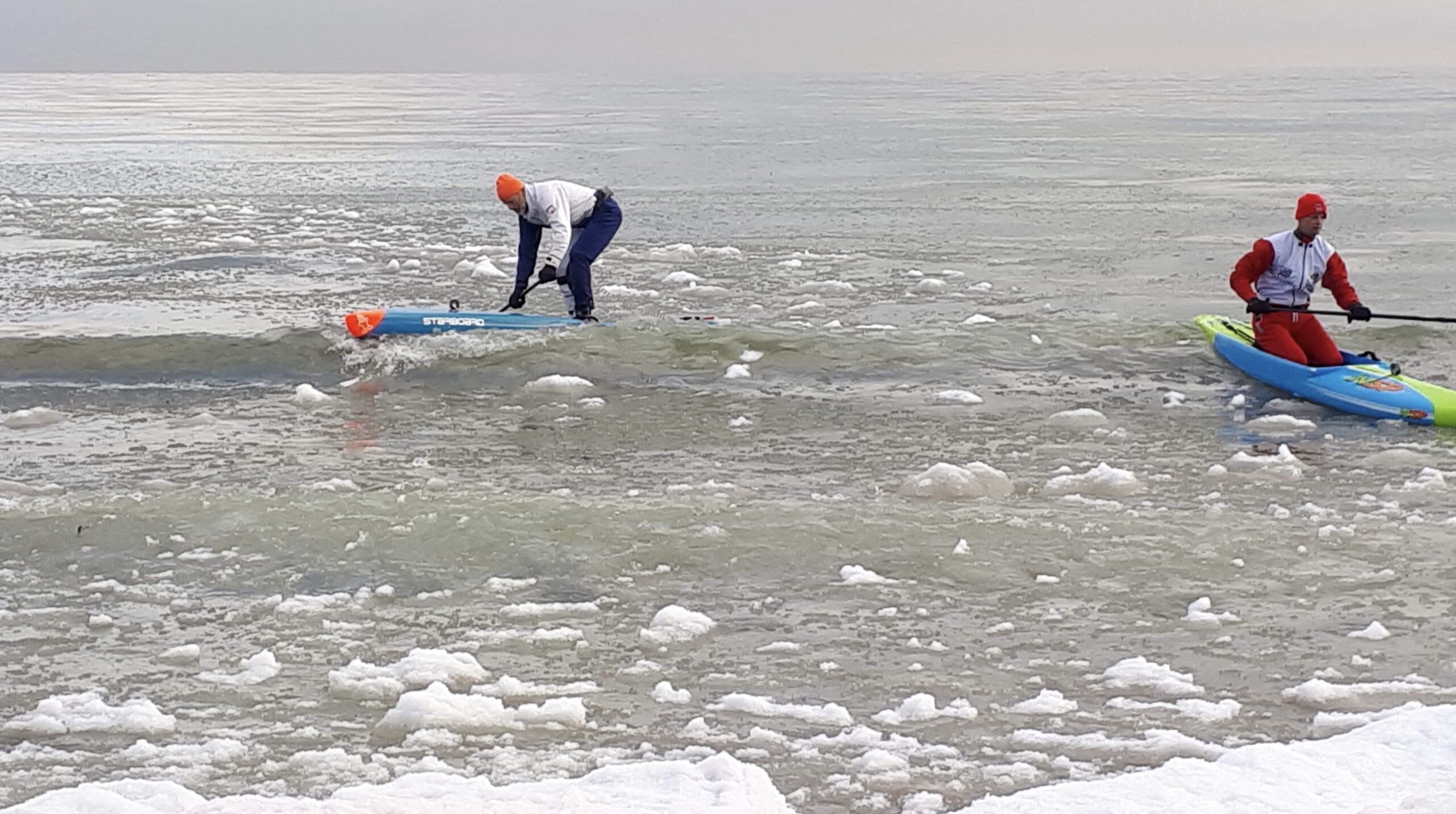
If you’re paddling in rougher water, ice can be impossible to spot until it is too late and, if you’re downwinding, you’ll be going a lot faster when you collide with it. Consider what is in the water before deciding to downwind or paddle when it is rough. Sometimes it’s better to take a pass than to venture out in water full of ice chunks.
Be extra careful moving around on your board
If you’re paddling on a dugout board that drains really well, you’re going to find the standing area of your board will get coated in a glaze of very slippery ice in sub-freezing temperatures. The same thing can happen on a flat-decked board that doesn’t puddle up where you stand.
If you’re paddling on a board that puddles around your feet, it’s unlikely to freeze and will just slush up instead. This means you can move around to a degree, but you’ll want to be very careful stepping back to turn or when downwinding as the area that doesn’t puddle up will be covered in smooth, very slippery ice.
I’ve stepped back and slid right off the back of my board. If you’re properly geared up this isn’t the end of the world, but it is still an unpleasant surprise that is avoidable if you remember that your board is going to get slippery if it starts icing up.
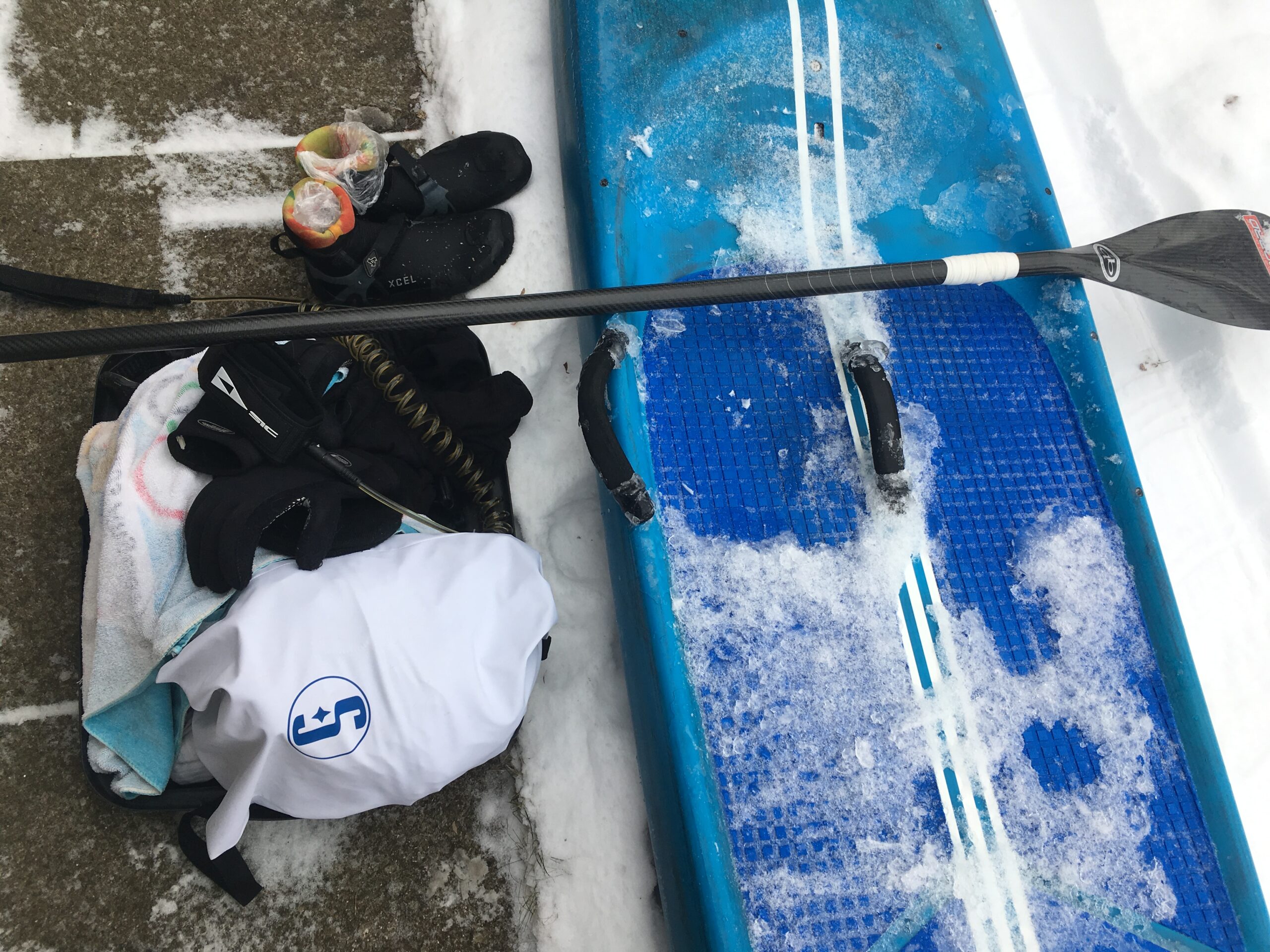
Stay away from moving water (current) and ice
Ice and currents are a bad combination. These conditions often occur in the spring. I’ve paddled on a river that has been open and safe one moment, only to find massive ice chunks, that could easily crush me, barreling down the river towards me from upstream. Know the water you’re paddling on and if it is a river, wait until the ice has completely flushed before going out.
Another thing to be careful of is paddling upstream of completely frozen over water when there is a current. You don’t want to get swept under the ice if you fall off and aren’t able to get back on your board in time.
More tips that will make your paddling more enjoyable
Over the last several years, I’ve discovered a lot of little things that can make a big difference in how enjoyable your winter paddles can be. Let me share them with you here rather than leave you to figure them out for yourself. If you’re an experienced winter paddler and have a useful tip that I fail to mention, please comment below and share it. I’m always interested in learning from others.
Wear socks under your boots
As it gets colder, 7mm or 8mm of neoprene isn’t going to be enough to keep your feet warm. Buy your boots big enough to allow for a pair of socks underneath – merino wool socks are the best. Get plastic produce bags from the grocery store and pull them over your socks, then stick your “bagged feet” into your boots. The bags will keep your feet dry, help your feet heat up more once you start to work, break the wind if it’s really windy, and allow you to slide your feet into and out of your boots much more easily than wearing just socks will. This system keeps my feet warm in all but the very coldest winter temperatures with wind chill values dropping below -20C. Even then paddling is bearable. I can’t remember the last time I had to get off the water in the winter because my feet were cold.
Use medical examination gloves under your neoprene gloves
I mentioned that 3mm neoprene gloves are ideal as they aren’t super thick and awkward so therefore don’t affect your grip too much. However, they’re pretty thin for really cold temperatures. What makes them usable and warm at even the coldest temperatures is layering them with medical examination gloves. Put these gloves on your hands first, and then slide them into your neoprene gloves. This layering helps break the wind, which will blow through 3mm of neoprene, and causes your hands to sweat. Your sweat gets warm and keeps your hands and fingers warm. I use blue nitrile gloves down to wind chills of -25C and it’s always bearable on my fingers. These gloves also protect any cuts or scrapes on your hands from exposure to bacteria that can be found inside dirty neoprene gloves.
Suit up at home before paddling
This is pretty self-explanatory. When it gets really cold you’ll want to gear up at home. This includes your boots. I usually load my board on the car, then gear up, then drive to where I launch.
Changing outside before you paddle is going to be really cold, and it is going to leave you chilled when you hit the water. It will take you a long time to warm up in really cold conditions, making much of your paddle unpleasant. In contrast, changing outside after paddling when you are all heated up usually isn’t too bad at all.
Warm your gloves on the car dashboard while driving to launch
I’ll put both my neoprene gloves and my nitrile gloves up on the dash over the windshield defrost vents, then crank the heat while driving to paddling. In the 10 minutes or so it takes to drive to where I launch, they get toasty warm. I’ll put them on just before I’m ready to get on the water and my hands will be warm right from the first stroke. This makes a huge difference on those –10 C or colder days when it can otherwise take a while to warm up.
Keep all your cold weather paddling gear in a big plastic tub and bring it with you every day
I fill a tub with everything from fins and screwdrivers, to extra gloves, toques, socks, plastic bags, etc. and toss it in the car every day when I go paddling. I’m ready for anything once I get to the water and see what the conditions are. Plus, when I am changing after paddling the lid is good for standing on so that I can keep my feet warm and dry.
Get a boot drying rack
These are big sellers in Canadian hardware stores in the winter and only cost around ten dollars. They sit over the heating vent on the floor and allow you to put your boots and gloves on it as soon as you get home. The warm air from the furnace blows into them and they are almost always warm and dry the next morning. See figure 1.

If you’re paddling every day, consider multiples of certain pieces of clothing/gear
If you’re using a dry suit, you’ll want multiples of the items you use the most for your under layer. This allows you to double layers up on really cold days and ensures that you’ve always got dry under layering when you need it. Despite your best efforts to keep your paddling socks dry with plastic bags, you’ll find they still get wet and sometimes don’t dry fully between sessions. Having at least two pairs of socks you can rotate for use inside your boots is essential if you paddle every day. Lastly, if you choose to go the wetsuit route and paddle every day, you may want to invest in a second wetsuit as they will be absolutely soaked after each paddle (whether you fall in or not) and can take a long time to completely dry. There is nothing worse than putting on wet clothes in cold weather. You’ll want to avoid that at all costs.
Tips for breaking ice
If you paddle enough in the winter, at some point you’re likely going to need to break ice. We’re not talking about thick ice-berg like chunks but rather thin sheet ice that forms overnight and then usually melts in the day once the sun hits it.
Breaking ice sounds a lot worse when you’re doing it than it actually is. It sounds like you’re absolutely destroying your board but, if you do it right, your board will come out unscathed. Make sure that you stand back enough on your board to get your nose up just enough to ride over the ice rather than plow through it. This both protects your board and allows it to behave like an icebreaker by riding slightly up on the ice, then breaking the ice underneath its weight. Remember, you’ll want to be careful stepping back on your board to get the nose up so you don’t slip. Boards with noses that turn upwards, like my Starboard All Star, are better for winter paddling and ice breaking than flat water boards with longer water lines and more piercing noses, like my Starboard Sprint, as you don’t have to move back as far to ride up over the ice.
Obviously, there’s a limit to the thickness of the ice you can break. To be safe you need to make sure the ice is not so thick that your paddle can’t easily break through it as well. If your board can break through the ice but your paddle can’t, you’re going to get stuck, which is not only inconvenient, but unsafe.
Clean as much of the ice off your board as you can before you take it out of the water
You’re going to find ice building up on your board. This isn’t going to hurt your board, it’s just going to make it a little heavier to paddle and carry to the car afterward. You’ll want to take a second in the shallow water when you get off your board to scrape as much of the ice off your board as you can. Once you get away from the water and your board gets a little drier, the ice on it will harden like rock and there’s no way you’ll be able to easily get it off. Unless you have a heated garage, when it gets really cold, you’re likely to find ice on your board the next morning. So, take a second to scrape what ice you can off of your board while it’s still in the water.
Get the ice off your dry suit legs before you get out of the water as well
If you wear a dry suit you’re likely to get a lot of ice building up around the bottoms of each leg. It can get pretty thick, especially if there’s a bit of a wind and some splashing off the nose of the board. Just as it is easier to remove ice off your board while it is still in the water, the same applies to your dry suit. Scrunch the material and pick at it while it is wet and a lot of it will come off at the water. If you wait till you get to your car you just might find it’s suddenly much harder. Too much ice around the bottoms of the pant legs can make it hard to get the suit off. So, if you’re planning on stopping for a coffee or going shopping for groceries on the way home and don’t want to do it in an icy dry suit, get the ice off immediately, rather than waiting till you’re about to change.
Winter paddling - the bottom line
Winter paddling is fun. Winter conditions, whether they are clear, crisp and brilliantly sunny or dark, gloomy and gray, can be beautiful. I’ll frequently sit down on my board and just look around. Gray winter skies can be surprisingly beautiful and underappreciated, and the thin ribbon of gray and white you see along the shore from out on the water is unique to winter paddling and can be pretty as well. If you’re fortunate enough to have a little snow falling, you’re in for a wonderful and unique winter experience that most people will never know.
Winter paddling is arguably safer than paddling in the spring and the fall, when you often aren’t geared up as well as in the winter and so can end up in more trouble if you fall in. For those that are serious about training, winter paddling can be extremely productive. With the right gear you’re not only safe, but comfortable enough to work just as hard, and paddle just as well, as you do in the summer.
I’ve been asked many times by those watching from shore as I get off the water, “Aren’t you cold?” I always reply that I am probably warmer than they are. I’m certainly warmer paddling every morning than I am walking my dogs every afternoon.
I’m occasionally accused of being reckless or doing something dangerous by those watching from shore. This is far from the truth. In fact, the most dangerous thing I do every morning, by a considerable amount, is driving to paddling through rush hour traffic. If you approach your winter paddling the way I’ve described here and don’t ever take any shortcuts with safety, you’ll be as safe in the winter as you are in the summer.
The most important thing to remember about winter paddling is that, whether in a group or solo, you’re pretty much on your own. There aren’t going to be others out there like there are in the summer. In many places, the marine police and rescue units shut down for the winter. It can take them an hour or more just to sortie if you get in trouble, let alone actually find you and help you. By then it might be too late. These realities shouldn’t deter you from winter paddling, but they should make you take everything safety related very seriously. Your margin for error is close to zero. If you understand that and make your decisions accordingly, being more safety aware than you are in the summer, you’ll be fine.
Those who live in warmer climates are missing out on an amazing experience. Those who live in northern climates who have access to safe open water in the winter should give it a try. There’s no reason paddling should be a three-season activity only.
You can probably get all the gear you need to get started for less than $1000, though if you opt for a good dry suit your gear budget is likely to cost you $1500 or more. However, when you realize that the gear, if you care for it properly, should last several seasons that cost seems pretty reasonable.
Here’s hoping this post inspires people to give winter paddling a try and provides those who already get out there with some new ideas that can enhance their experience. Please comment and let us know about your winter paddling experiences. We’re genuinely interested in hearing your stories!
Happy winter paddling!
Additional Resources
Winter related posts from the our archives;
https://paddlemonster.com/explore-stand-up-paddleboarding/cold-water-safety-no-joke/
https://paddlemonster.com/stand-up-paddleboard-articles/strategies-for-beating-the-winter-cold/
https://paddlemonster.com/explore-stand-up-paddleboarding/outrigger-canoe/oc-winter-training/
https://paddlemonster.com/uncategorized/embrace-cold-weather-paddling/
https://paddlemonster.com/stand-up-paddleboard-gear-1/gear-review-wetsox-split-toe-therms/
https://paddlemonster.com/safety-1/paddling-solo-safely/
https://paddlemonster.com/how-to-stand-up-paddleboard/deciphering-the-wind-forecast/
https://paddlemonster.com/stand-up-paddleboard-gear-1/safety-thing-yall/
Paddle Events
DeSatnick Foundation Around the Cape Paddle
Ohio River Paddlefest Races
The Circumnavigation-Tilghman Island 2024
Recent Classifieds
2 Boards: Both SIC Bullet 12’6″ x 28.5″
- Sell
- 15 hours ago
- Stand Up Paddleboard
- 02813 Charlestown , Rhode Island United States
- 14 views
SIC XRS 14 x 22
- Sell
- 4 days ago
- Stand Up Paddleboard
- Chattanooga , Tennessee United States
- 50 views
Wanted! Ocean / downwind 14 foot SUP
- Buy
- 5 days ago
- Stand Up Paddleboard
- Main Street , 07005 Boonton , New Jersey United States
- 48 views
one edge pro 2.0 hollow 14′ x 23.5”
- Sell
- 6 days ago
- Stand Up Paddleboard
- 53066 Oconomowoc , Wisconsin United States
- 90 views
2021 Starboard Allstar 14×24 5
- Sell
- 1 week ago
- Stand Up Paddleboard
- 21085 Joppatowne , Maryland United States
- 90 views
Subscribe for Premium Content and Coaching
Join the Paddle Monster paid Plan Today!
You May Also Like


Paddle Foundations: The Six Fundamentals of Paddle Technique
